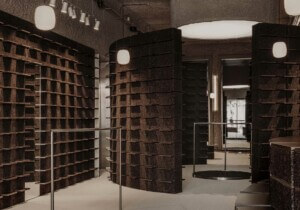In 1939, Milan’s first multistory car park opened. Garage Traversi, designed by Giuseppe De Min, became a historic example of Italian rationalism with its curved facade, steel-framed windows, and innovative car-lift system. As part of an ongoing effort to convert the formerly abandoned structure into a luxury shopping destination, part of ex–Garage Traversi is now home to AP House, a new retail concept from haute horologist Audemars Piguet.
Lissoni & Partners transformed five floors and the roof of the building into an experiential retail concept. Each floor serves a different function, from an exhibition space and lounge to a bar, shop, collector’s room, and inspection and customer care area. To work across six total floors and more than 17,222 square feet prompted a challenge for the designers “to connect the different floors, not in a physical way but in an aesthetic way and, at the same time, in a functional way,” explained the studio’s founder and principal, Piero Lissoni.

The designers project the watchmaker’s heritage and ethos beginning at the entry. An ebony wall juxtaposed with a lateral glass panel houses a myriad of optical illusions—a foreshadowing of the immersive digital experience Dreamscape one floor above. Its inclusion is a gesture toward the brand’s positioning as both a heritage and a future-forward watchmaker.

From the entry, a sculptural spiral staircase (a nod to the mainspring of a watch) connects three floors. The staircase is made of a special black stainless steel, recalling some of the materials found in Audemars Piguet watches. The steps are surrounded by a curved wall that faintly glows. “Around the staircase is onyx. We cut the onyx and put an LED light inside,” Lissoni explained. Essentially, “it’s a huge lamp inside the building.” These thin veneers of stone have been used recently in other stunning architectural projects, like REX’s Perelman Performing Arts Center in New York, and all may be a nod to the iconic Gordan Bunshaft–designed Beinecke Library at Yale, but Lissoni turns the subtle glow inward in Milan.
On the other floors, the designers continue to play with light. Crystal and semitransparent operable partitions help diffuse natural sunlight throughout the space when closed and reveal cyber maps when opened. Inside a circular niche, gridded walls light the room and hold display cases for timepieces. And in the servicing center, glass walls allow visitors to see watchmakers fixing or inspecting watches, but an option to fog the glass hides the manufacturing from view when required.


Similarly, the exhibit floor houses what Lissoni refers to as the “museum wall,” a dark, floor-to-ceiling wall comprising a concentration of boxes that display timepieces. Depending on the time or event, AP House may choose to display anywhere from ten to 100 watches: Inset boxes can either hide or reveal them without any watch appearing to be missing. When closed, the apertures form geometric patterns on the wall, like a backdrop. Lissoni explained: “The display system is very complicated because we try not to be traditional. For example, we designed vertical towers, and inside each vertical tower is one watch—that’s it.”

Visual references to Milan can be found in the gridded and rectilinear details along the walls, windows, and ceiling. These elements all nod to the building’s history, strengthened by the collection of vintage furniture and design pieces made by famous Milanese designers like Achille Castiglioni, Franco Albini, and Ettore Sottsass.
“Design in that way is like glue,” said Lissoni. It sandwiches together the many eras of the timekeeper’s legacy with the new city they call home.
Project Specifications
-
- Architect: Lissoni & Partners
- Interior design: Lissoni & Partners
- Lighting design: Sonexco
- AV/acoustics: Delta Tecno Studio
- General contractor: Sogeco
- Furniture: B&B Italia, Cassina,
FLOS, Fritz Hansen, Knoll, Living Divani, Salvatori, Vitra











